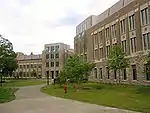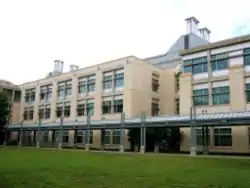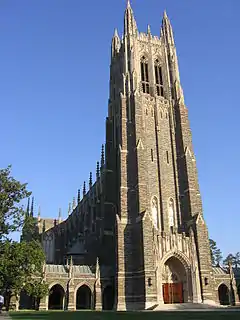Duke University Pratt School of Engineering
The Pratt School of Engineering[3] is located at Duke University in the United States. The school's associated research, education, alumni and service-to-society efforts are collectively known as Duke Engineering.[4]
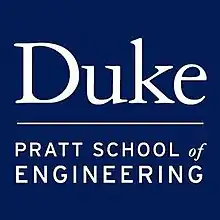 | |
| Established | 1939 |
|---|---|
Parent institution | Duke University |
| Dean | Ravi V. Bellamkonda, PhD |
Academic staff | 156 |
| Undergraduates | 1,257[2] |
| Postgraduates | 1,281 |
| Location | |
| Website | pratt.duke.edu |
Research expenditures at Duke Engineering exceed $88 million per year. Its faculty is highly ranked in overall research productivity among U.S. engineering schools by Academic Analytics.[5] Ten members of the Duke Engineering faculty are members of the prestigious National Academy of Engineering.[6]
The Pratt School of Engineering also maintains these academic departments:[7]
- Biomedical Engineering
- Civil & Environmental Engineering
- Electrical & Computer Engineering
- Thomas Lord Department of Mechanical Engineering & Materials Science
Duke engineering faculty and alumni have contributed to a number of important high-impact technologies, including clinical ultrasound imaging, restoration of hearing by cochlear implant, mega-pixel photography and metamaterials.
The school was created by Duke's Board of Trustees in 1939. It was named in 1999 following a $35 million gift by Edmund T. Pratt Jr., a 1947 graduate and former chief executive of Pfizer.[8] The Duke University Pratt School of Engineering celebrated its 75th anniversary in 2014–2015.[9]
Duke Engineering is led by Vinik Dean of Engineering Ravi V. Bellamkonda.[10]
Education
Undergraduate
Duke awards the Bachelor of Science in Engineering (BSE) with majors available in biomedical, civil, environmental, electrical & computer, and mechanical engineering.[11]
Master's
Duke awards master's degrees in:[12]
- Biomedical Engineering
- Civil & Environmental Engineering
- Electrical & Computer Engineering
- Mechanical Engineering & Materials Science
- Artificial Intelligence for Product Design
- Cybersecurity
- Engineering Management
- Financial Technology (FinTech)
- Materials Science & Engineering
Doctorate
Duke's Pratt School of Engineering grants PhDs in:[13]
- Biomedical Engineering
- Civil & Environmental Engineering
- Electrical & Computer Engineering
- Mechanical Engineering & Materials Science
Online Graduate Certificates
Standalone graduate-level certificates, intended for working professionals, are granted in:[14]
- AI Foundations for Product Innovation
- Business Foundations for Engineers
Research and Innovation
Faculty
The school's faculty research laboratories have played major roles in the development of many high-impact technologies,[15] including:
- Real-time ultrasound imaging in clinical practice (1976)
- Continuous interleaved sampling strategy for cochlear implants (1991)
- First working "invisibility cloak" using metamaterials (2006)
- World's first gigapixel camera (2012)
Duke Engineering faculty research is grouped into four signature themes:[16]
- Data Science, Advanced Computing and Intelligent Systems
- Materials Discovery and Development
- Personal, Environmental & Population Health
- Resilient Systems and the Environment
Student
Since July 2018, Duke Engineering students have held the Guinness World Record for inventing the world's most fuel-efficient vehicle—powered by a fuel cell, it achieved 14,573 miles per gallon equivalent.[17] In 2019, Duke Engineering students earned a second Guinness World Record for the world's most efficient all-electric vehicle—797 miles per kilowatt-hour.[18]
Leadership
Ravi V. Bellamkonda, became the Vinik Dean of Engineering on August 1, 2016.[19]
Former Deans
- William H. Hall, 1939-1953
- Walter J. Seeley, 1953-1962
- James L. Meriam, 1962-1969
- George Pearsall, 1969-1974, 1982-1983
- Aleksandar Vesic, 1974-1982
- Earl H. Dowell, 1983-1999
- Kristina M. Johnson, 1999-2007
- Robert L. Clark, 2007-2008
- Thomas C. Katsouleas, 2008–2015
- George Truskey, 2015-2016
History
The precursor to the school of engineering dates back to 1851, when Duke was known as Normal College and located in Randolph County, North Carolina. At that time, engineering was included in a classical course for seniors. A course in engineering was introduced in 1887, eventually becoming a regular course offering in 1903. At that time, engineering courses were limited to such fields as architecture and surveying until 1924, when Trinity College was renamed Duke University. Engineering was taught in the new separate departments of civil and electrical engineering. In 1931, a mechanical engineering department was created. Duke's Board of Trustees created the College of Engineering in 1939, with William H. Hall its first dean.
The College of Engineering graduated its first female graduates in 1946. The next year, the three departments moved from East Campus to West Campus. It became the Duke School of Engineering in 1966. Two years later the school's first black students graduated. The Division of Biomedical Engineering was created in 1967 — the first accredited biomedical engineering department at a U.S. university — in September 1972.[20]
In 1997, the Master of Engineering Management was established.
The school was renamed the Edmund T. Pratt Jr. School of Engineering in 1999, in honor of the 1947 graduate and former CEO of Pfizer.
Facilities
Duke Engineering occupies more than 300,000 net square feet of educational, administrative and research space on and near the Duke campus in Durham, North Carolina.[21]
The Duke Engineering campus is adjacent to Duke University Medical Center and 10 miles from Research Triangle Park.
Pratt's faculty, labs, and courses can be found in Hudson Hall, the Nello L. Teer Engineering Building, the Fitzpatrick Center for Interdisciplinary Engineering, Medicine and Applied Sciences (also known as FCIEMAS), Gross Hall, the North Building, the Levine Science Research Center (also known as the LSRC) and in The Chesterfield, a former cigarette factory near downtown Durham that has been redeveloped into academic and industry research space.[22]
Hudson Hall
Hudson Hall is the oldest engineering building at Duke, constructed in 1948. It was renamed to honor Fitzgerald S. "Jerry" Hudson (E'46) in 1992.[23]
Nello L. Teer Building
The Nello L. Teer Library Building opened in 1984. Located adjacent to Hudson Hall, it is now called the Nello L. Teer Building, and houses the Dean's offices, a computing lab, a circuits lab, an auditorium and a student lounge. The building's name honors Teer, its donor and a Durham, North Carolina-based builder and philanthropist.[23]
Fitzpatrick Center
The Fitzpatrick Center for Interdisciplinary Engineering, Medicine and Applied Sciences (FCIEMAS) opened in August 2004. Research facilities focus on the fields of photonics, bioengineering, communications, and materials science and materials engineering. The aim of the building was to emphasize interdisciplinary activities and encourage cross-departmental interactions. The building houses numerous wet bench laboratories (highlighted by a world-class nanotechnology research wing), offices, teaching spaces, and a café.[23] FCIEMAS is also home to the Master of Engineering Management Program offices. The construction of FCIEMAS took more than three years and cost more than $97 million.
Levine Science Research Center
The Levine Science Research Center (LSRC) is a 341,000-square-foot (31,700 m2) facility. When it was opened in 1994, the LSRC was the largest single-site interdisciplinary research facility in the U.S.. Its classrooms are shared by several departments, but the majority of its offices and laboratories are utilized by the Nicholas School of the Environment, the Pratt School of Engineering, the Center for Cognitive Neuroscience and Developmental and the departments of Computer Science, Pharmacology and Cancer Biology and Cell and Molecular Biology.[24] The building was named for Leon Levine, the CEO of Family Dollar Stores.[23]
Wilkinson Building
This 150,000-square-foot building will open in late 2020 with new spaces for education and research related to interdisciplinary themes of improving human health, advancing computing and intelligent systems, and sustainability.[25]
The Wilkinson Building, located at Research Drive and Telcom Drive next to Bostock Library, will also house Duke Engineering's entrepreneurship initiatives.
The building's name recognizes lifetime philanthropic and service contributions of Duke Engineering alumnus Jerry C. Wilkinson and family.[26]
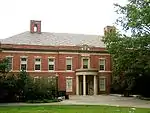 Hudson Hall |
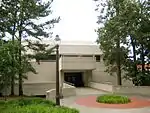 Nello L. Teer Building |
Notable alumni
- M. Katherine Banks—Phytoremediation of petroleum contamination
- Robert E. Fischell—Leadership and innovation in bringing aerospace technology to implantable medical devices[27]
- William A. Hawkins III—Leadership in biomedical engineering and translational medicine
- Fred C. Lee—High-frequency power conversion and systems integration technologies
- Blake S. Wilson—Engineering development of the cochlear implant
- Kathryn R. Nightingale— Invention of Ultrasound Acoustic Radiation Force Imaging
Notes
- "Duke Engineering - Duke Pratt School of Engineering".
- "About Duke Engineering". Duke University Pratt School of Engineering. Retrieved 15 October 2019.
- "Duke Pratt School of Engineering". pratt.duke.edu. Duke University. Retrieved 15 October 2019.
- "Duke Engineering (@DukeEngineering) | Twitter". twitter.com. Retrieved 2018-11-16.
- "Duke Engineering Facts & Stats". Duke Pratt School of Engineering. Retrieved 15 October 2019.
- "Duke Members of the National Academy of Engineering". Duke Pratt School of Engineering. 8 May 2015. Retrieved 15 October 2020.
- "Departments & Centers". Duke Pratt School of Engineering. 2 April 2012. Retrieved 15 October 2020.
- "Distinguished Alumnus, Edmund Pratt | Duke magazine". dukemagazine.duke.edu. Retrieved 2018-11-16.
- "Our History". Duke Pratt School of Engineering. 2014-01-23. Retrieved 2018-11-16.
- "Dean's Welcome". Duke Pratt School of Engineering. Retrieved 16 November 2018.
- "Undergraduate Studies". Duke Pratt School of Engineering. 15 March 2012. Retrieved 15 October 2020.
- "Master's Degree Programs". Duke Pratt School of Engineering. 6 September 2017. Retrieved 15 October 2020.
- "PhD Programs". Duke Pratt School of Engineering. 19 March 2012. Retrieved 15 October 2020.
- "Online Graduate Certificates". Duke Pratt School of Engineering. 29 May 2020. Retrieved 15 October 2020.
- "Research Timeline". Duke Pratt School of Engineering. 2014-10-17. Retrieved 2018-11-16.
- "High-Impact Research". Duke University Pratt School of Engineering. Retrieved 7 August 2019.
- "Duke students make Guinness record for world's most efficient vehicle". newsobserver. Retrieved 2018-11-16.
- "Duke students set world record with electric vehicle". ABC 11 WTVD. 11 July 2019. Retrieved 3 September 2019.
- "Duke University Names New Engineering School Dean - Duke Pratt School of Engineering".
- Biomedical Engineering Celebrates 30 Years, Pratt School of Engineering, November 2001
- "About Duke Engineering | Location". Retrieved 20 August 2019.
- "The Chesterfield Re-Engineered: Collaborative Space for High-Impact Discovery and Entrepreneurship Opens". Duke University. Retrieved November 9, 2018.
- About Pratt Facilities
- "Duke University Maps".
- "Duke Engineering New Building". Retrieved 2019-05-23.
- "Duke's New Engineering Building Named to Honor Wilkinson Family". Duke Pratt School of Engineering. 15 October 2020. Retrieved 15 October 2020.
- "Citation for Dr. Robert E. Fischell, member, National Academy of Engineering". National Academy of Engineering. Retrieved 30 May 2019.
External links
- "Duke Engineering flagship website". Retrieved 23 May 2019.
- "Duke Engineering Wilkinson Building website". Retrieved 15 October 2020.
